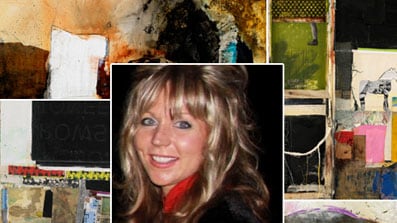No Sotheby’s or Christie’s for artist Michel Keck: eBay is her auction house of choice. In early 2006, she became a Platinum Power Seller on the shopping website, with sales of her paintings, collages and their inkjet reproductions netting more than $40,000 in one 30-day period (she averages more than $25,000 every month). Keck developed such a following that she was able to leave the website and its aggressive fee structure to start her own online store. Now, after a three-year hiatus, eBay’s millionaire painter is back.
Gallery: Michel Keck's eBay Art

“Google ‘Abstract Art’, and you’ll see me on the second page,” she told The Daily Beast via telephone. “I used to come up on page one, but there are people fighting for it, plus they’re always changing the formula. You can spend a few hours a day on search-engine optimization.” A self-taught 39-year-old Hoosier with a megawatt smile, big blond hair, and a fondness for emoticons on her Facebook wall, Keck also sells her art through an online store; a brick-and-mortar gallery in Rensselaer, Indiana, that she owns with her ex-husband; and a series of regional framing shops, including one in Colorado that capriciously boasts on its website, “Kemper Galleries is the largest free-standing art gallery in the state of Colorado, since 1969.” With her real-estate assets, web outlets, and quarter-million dollar earnings, Keck enjoys the “millionaire” financial status that many artists only dream of.
The Metropolitan Museum they’re not, but shops like Kemper Galleries fill the spaces above sofas around the country—just ask Thomas Kinkade, “America’s most collected artist.” A big influence on Keck, Kinkade has made and lost millions from QVC specials, shopping-mall gallery franchises, and the Village at Hiddenbrooke, a branded residential community based on the bucolic homes that dot his painted landscapes. Media Arts Group, the publicly traded company that distributes his work, claims that one in 20 homes in the U.S. feature some form of Kinkade’s art.
Keck’s not quite to Kinkade levels, but her business is a big one, and it’s as far from New York City’s blue-chip galleries as, well, Rensselaer, Indiana. But in some ways the machine is surprisingly similar, even a bit illustrative of issues that the more rarefied art world can have a hard time addressing.
Stylistically, her practice is varied, so much so that her bio notes, “When viewing Keck's portfolio for the first time one is under the belief that the works presented are the creations of several talented artists,” and that’s mostly true. She sometimes paints in pleasing abstract blobs connected by dribbles and scribbles of colors that work together like a decorator would hope. She makes Pop Art-inspired figurative collages of dogs, with their heads cocked cutely and their eyes impossibly wide open. And there are mixed media canvases, too—big ones with ribbons of aluminum foil that wink at the walls of Andy Warhol’s factory and camels from cigarette packs conjuring up Richard Prince and the Marlboro Man. The artistic moments she references have been so completely absorbed by culture that there isn’t the faintest hint of an avant-garde sediment left, nor is it clear at first whether her references are there with a knowing nod or simple synchronicity.
When I asked who her influences are, she told me, “I don't know, really. I don't know much about art—like, I've never studied it and never really went to many museums or read books. I know I do like Rauschenberg a lot, and Basquiat. Those are the only two I can say [that] when I look at their art I am just so pulled into it, like I feel I 'get it'.” Once you know that about Keck, it shows in her work.
Keck’s abstraction not only marks a shift from the realist consumer art of entrepreneurial creators like Kinkade, or Norman Rockwell before him, or Eadweard Muybridge before that, but also demonstrates an increasing ease with, even a desire for, nonrepresentational art in the mainstream. “My kid could do that” might still be a punch line, but there’s proof far from the refrigerator door that it’s not just children and effete elites who are crazy about squiggles and cuckoo for color fields.
Keck has taken a lesson from museum stores and started reproducing her creations on any surface that will hold an image and sell. “If I like the company, and I like the product, I’ll put my art on anything,” she said. Fittingly, for someone so internet savvy, she’s not as focused on scarves, mugs or tins as the MoMA, but instead on skins, the patterned covers that decorate consumer electronics. She has 389 variations of these cast vinyl stickers for sale. With them, you can wrap a laptop, an iPhone, an e-reader, or a video game console in a work like Disarray. According to DecalGirl, a leading skin company, “This decidedly abstract yet versatile design looks a bit like a desert scene gone dreamland with its conglomeration of melting teal blue sky, rusty tan and brown horizon, and a bit of a red and white disaster in the middle.” It’s a jumble, it’s $7.99, and people want it. Twenty-two-year-old Hayli Wells, a DecalGirl customer, liked the print so much that she asked if the company could make a version to fit her Nokia phone. They were happy to oblige. Wells and thousands of others have found an unexpected forum for abstract art, and Keck has found another market. She loves that.
Her artist statement starts: “I'm a living artist making a six figure income doing what I was born to do… create.” It’s easy to let cynicism wash the sincerity out of those words, as I did when I first read them, but taken at face value, and after talking with Keck, they’re quite remarkable. Making a significant annual income—Keck’s MySpace page puts it at “$250,000 and Higher,” which she confirmed but declined to elaborate on when I asked—by doing what you believe you were born to do is rare; that her vocation is visual art makes it practically magic. But her financial proclamations are also part of an economic dynamic understood well by galleries, collectors, and auction houses in every sector of the art world.
Veblen goods—named for Thorstein Veblen, the turn of the century sociologist and economist best known for his Theory of the Leisure Class—are commodities that increase in appeal as they increase in price. Super-luxury cars and watches are common examples, but art objects on the market often adhere to this theory. Unsurprisingly, those involved in the buying and selling of culturally significant objects will parry if ever asked about this trend: money implies demand, supply, and a handful of other brutish factors that fly in the face of capital-A-Art’s purported nobility, while circling the basest consuming and collecting impulses. When Damien Hirst unveiled his $100 million diamond-crusted monstrosity For the Love of God, there was outrage. At least some of it stemmed from the audacity of such a price preceding any critical response.
Although almost everyone in the art industry survives by selling things, cost isn’t really a public matter. Pictures with price tags are reserved for restaurants and cafes, while real value is built through whisper campaigns waged among the triumvirate of artists, sellers, and collectors in the primary market, and sellers and auction houses in the secondary one, where, amazingly, even buyers have a vested interest in a high price, because a good deal can diminish a work’s actual value. Keck gets the Veblen bit—her dealers help set her prices too—but passes on the hushed tones of cabals and cocktail parties for the shouts and shenanigans of a snake-oil saleswoman. One of her website’s biographical sections reads: “While there was a time a few years ago that you could purchase a Keck original painting for a few hundred dollars, that is no longer the case. Today, Keck's original abstract paintings and mixed media assemblages are selling for thousands of dollars each.”
In another section of the site, this one dedicated to her $850 an-hour art consulting business, Keck cautions, “Consultations are offered by the hour only, do not send emails requesting a 1/2 consultation, I don't offer that. […] If my consultation price is too high please go elsewhere. […] My artist consultation service price is set at what my time is worth.” Her time and her paintings are worth a quite a bit, or at least she says they are over and over again with smart, self-actualizing panache.
“If I'm forced to put myself in to an 'ism,' then my ‘ism’ of choice is raw-ism," Keck has said. She even goes by “The Raw Artist”, which is as much a nod to her preference for uncooked food as her art career. But upon closer inspection, that career seems quite well-done. It even employs a lot of the same heat as the establishment she pits herself against. Perhaps the better label would be another she likes to use: “artrepreneur”. That one seems the most applicable to Michel Keck, and a handful of others in the art world who are closer to that than they would ever admit.
Plus: Check out Art Beast, for galleries, interviews with artists, and photos from the hottest parties.
Graham T. Beck has written about art, urbanism, and his problems for The New York Times, Frieze, The Believer and other newspapers and magazines.






